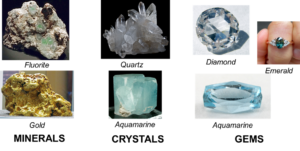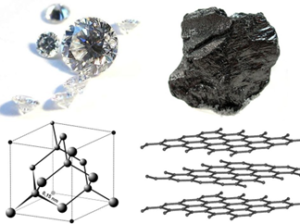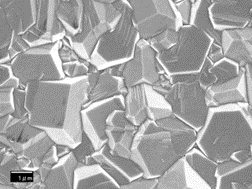Gemstones and Geology Today
Jewelry is a symbol of wealth, beauty, and love that has endured throughout history. Today, jewelry is one of the most common gifts and symbols of luxury worldwide. For example, almost $10 billion worth of jewelry was purchased as Valentine’s Day or Mother’s Day gifts in 2017 in the United States, and weddings account for 50% of the annual gold demand in India. In addition to its commercial value, the raw materials of jewelry — gemstones — are of great scientific importance in geology research in the study of historical geological conditions resulting in these scarce treasures. Given the lasting importance of gemstones, let’s delve into the science of their formation and what the future for these treasures may look like!

Minerals, Crystals, and Gems
Minerals are solid inorganic substances that occur naturally in the environment either as single minerals (i.e. calcite, which makes up marble) or mixtures of different minerals (i.e. rocks and granite). Crystals are natural forms for most minerals with a repeating orderly geometric pattern of atoms; crystals can grow from vapor, melted rock, or mineral rich water. Differences in the temperature, pressure, chemical composition, and space cause variations in the shape, appearance, and properties of crystals as they grow. The chosen few crystals that have been cut and polished by jewelers become gemstones. Selected from crystals, a gem’s value is determined by its size, rarity, durability, beauty, and historical significance. The weights of gemstones are measured in carats, deriving from the Mediterranean tree carob whose seeds were historically used as a standard in weighing gemstones and other precious stones.

Properties of Crystals
A crystal’s properties are determined by its atomic makeup and structure. For example, emerald and aquamarine are formed from the same mineral (beryl) but feature different impurities resulting in different colored gemstones. The shape of a crystal is determined by either one of the seven atomic crystal system arrangements. The type and therefore strength of the atomic bonds also determine the hardness of a crystal. Metallic bonds form softer crystals (i.e. gold), ionic bonds form intermediate crystals (i.e. rock salt), and covalent bonds form the hardest crystals (i.e. diamond). Colors of crystals result from light interacting with electrons of atoms and thus depend on the atomic makeup of the material. As electrons absorb some of the energy from light, the unabsorbed wavelengths of light remaining is what our eyes see. For example, sapphires appear blue because they absorb red light and emit blue light. Furthermore, there are even some fluorescent crystals, such as fluorite and calcite, that are able to absorb high energy ultraviolet light invisible to the naked eye but then emit visible light at different wavelengths, causing them to visibly glow under ultraviolet light.

Jewelry, the Environment, and Human Rights
High demands for jewelry have drastically magnified the mining industry. Diamond and gold mining have generated over $300 billion in revenue globally every year. However, the conditions under which these treasures are mined are brutal and the demand for crystals is quickly surpassing the supply of these finite resources. Diamonds, one of the most popular gems, have been found to be 970 million to 3.2 billions years old. With about 90 million carats of diamonds mined globally every year, their formation is much slower than the rate at which they are consumed. Furthermore, for every million grams of mined material from a diamond deposit, there will be only 5 grams of crystals and only 20% of those will be deemed high enough quality to be cut for jewelry.
Not only are the deposits of diamonds and other gems descending, but overmining of gemstones also has detrimental environmental impacts such as disturbed land masses, endangered wildlife, polluted waterways and soil, and displaced communities. Moreover, workers of the mines operate under severe conditions. Rates of injury and mortality among children working in these mining pits are high, and much of this exploitation for resources occurs in disadvantaged developing countries. The 2018 Human Rights Watch report entitled “The Hidden Cost of Jewelry” scrutinized the policies and practices of the 13 major global jewelers that collectively generated about $30 billion in revenue for having responsible sourcing policies that fell short of international standards.

The Future of Gemstones
The concept of ethical jewelry is trending with consumers today being conscious of the impacts of their purchases on the world. Gemstones have been the most difficult to trace of the jewelry supply chain, however, the growing demand for ethical jewelry is spurring new certifications focused on artisanal gem mines. Additionally, repurposing vintage gemstones and synthesizing gems in a lab provide other options that avoid questions of mining ethics. Over the past decade, researchers have optimized a technique for lab-grown diamonds called chemical vapor deposition (CVD) that crystallizes carbon on diamond seeds. This technique has been refined to create synthetic diamonds indistinguishable from their naturally mined counterparts, and the popularity of these lab-grown gemstones is growing steadily. The production of synthetic gemstones in the US has already increased by 29% over the year of 2020 with the expectation to expand throughout this decade. Scientists are hopeful that these synthetic or cultured diamonds could be the future of the jewelry industry. By leaving nature to its miraculous process of crystallization and avoiding the unethical and environmentally hazardous processes of mining finite resources, lab-created gems may be the shiny and ethical future that the jewelry industry needs.
Peer Editor: Runfan Yang